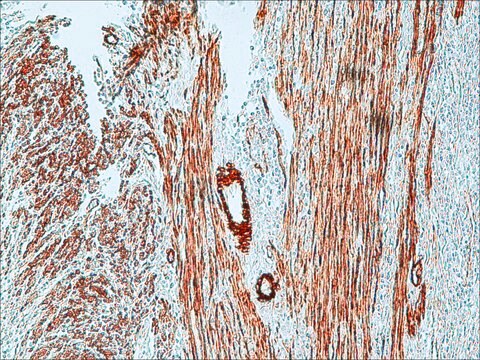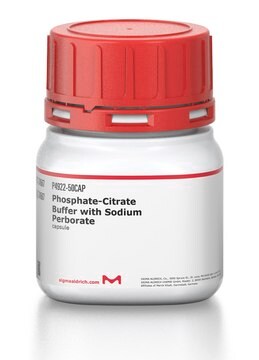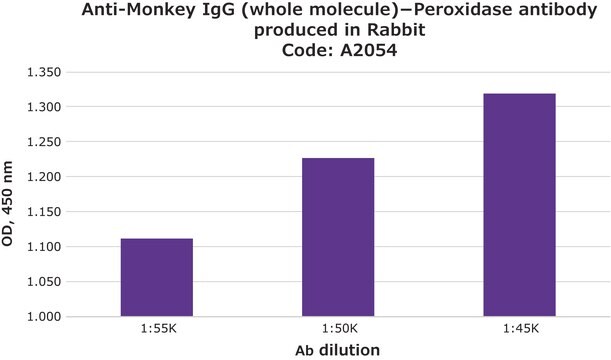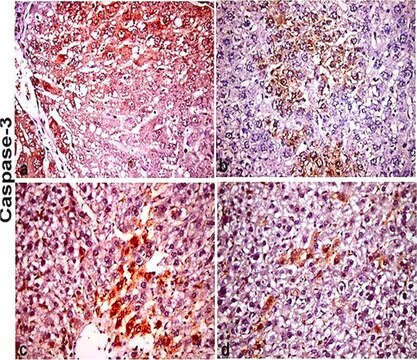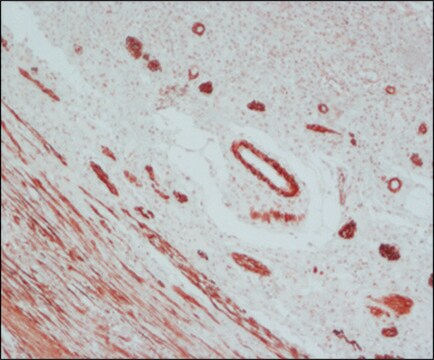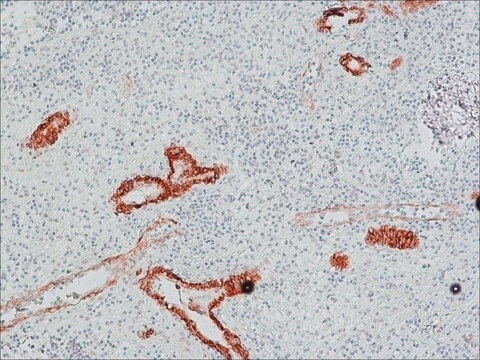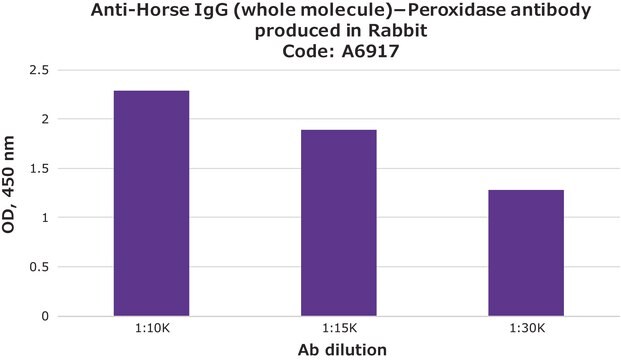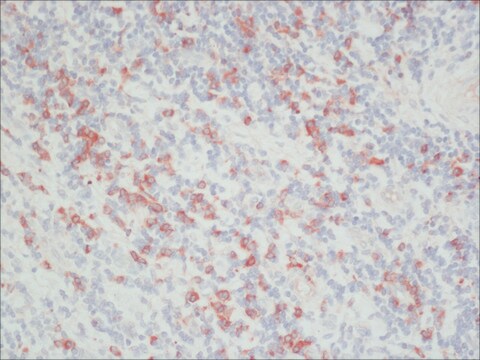A6782
Anti-Mouse IgG (whole molecule)–Peroxidase antibody produced in sheep
affinity isolated antibody, buffered aqueous solution
Synonym(s):
SAM
Sign Into View Organizational & Contract Pricing
All Photos(1)
About This Item
Recommended Products
biological source
sheep
Quality Level
conjugate
peroxidase conjugate
antibody form
affinity isolated antibody
antibody product type
secondary antibodies
clone
polyclonal
form
buffered aqueous solution
technique(s)
direct ELISA: 1:10,000
shipped in
dry ice
storage temp.
−20°C
target post-translational modification
unmodified
Looking for similar products? Visit Product Comparison Guide
Related Categories
General description
Mouse IgG is a plasma B cell derived antibody isotype defined by its heavy chain. IgG is the most abundant antibody isotype found in mouse serum. IgG crosses the placental barrier, is a complement activator and binds to the Fc-receptors on phagocytic cells. The level of IgG may vary with the status of disease or infection.
Horseradish Peroxidase (HRP) is an enzyme that catalyzes the conversion of chromogenic substrates such as o-phenylenediamine (OPD), 4-chloro-1-naphthol 3,3′,5,5′-tetramethylbenzidine (TMB), 3,3′-Diaminobenzidine (DAB) or 2,2′-azino-bis(3-ethylbenzothiazoline-6-sulphonic acid) (ABTS); chemiluminescent substrates such as CPS-3 (enhanced luminal) and fluorogenic substrates such as Ampliflu™ Red into detectable chromophores, light-emitters or fluorescers, respectively.
Horseradish Peroxidase (HRP) is an enzyme that catalyzes the conversion of chromogenic substrates such as o-phenylenediamine (OPD), 4-chloro-1-naphthol 3,3′,5,5′-tetramethylbenzidine (TMB), 3,3′-Diaminobenzidine (DAB) or 2,2′-azino-bis(3-ethylbenzothiazoline-6-sulphonic acid) (ABTS); chemiluminescent substrates such as CPS-3 (enhanced luminal) and fluorogenic substrates such as Ampliflu™ Red into detectable chromophores, light-emitters or fluorescers, respectively.
Specificity
Sheep polyclonal anti-Mouse IgG (whole molecule)–Peroxidase antibody reacts with mouse IgG in vitro and in mouse serum and biological fluids. It does not react with human serum proteins.
Application
Sheep polyclonal anti-Mouse IgG (whole molecule)–Peroxidase antibody may be used to detect and quantitate the level of IgG in mouse serum and biological fluids via chromogenic, chemoluminescent or fluorogenic immunochemical or immunohistochemical techniques. It may also be used as a secondary antibody in assays that use mouse IgG as the primary antibody. Primary T cells isolated from buffy goats were analyzed by western blot using HRP-conjugated sheep anti-mouse IgG as the secondary antibody.
Other Notes
Antibody adsorbed with human serum proteins.
Physical form
Solution in 0.01 M phosphate buffered saline, pH 7.4, containing 1% bovine serum albumin with preservative.
Preparation Note
Prepared using the periodate method described by Wilson, M.B., and Nakane, P.K., in Immunofluorescence and Related Staining Techniques, Elsevier/North Holland Biomedical Press, Amsterdam, p215 (1978).
Legal Information
Ampliflu is a trademark of Sigma-Aldrich Co. LLC
Disclaimer
Unless otherwise stated in our catalog or other company documentation accompanying the product(s), our products are intended for research use only and are not to be used for any other purpose, which includes but is not limited to, unauthorized commercial uses, in vitro diagnostic uses, ex vivo or in vivo therapeutic uses or any type of consumption or application to humans or animals.
Not finding the right product?
Try our Product Selector Tool.
Signal Word
Warning
Hazard Statements
Precautionary Statements
Hazard Classifications
Aquatic Chronic 2 - Eye Irrit. 2 - Skin Irrit. 2 - Skin Sens. 1
Storage Class Code
12 - Non Combustible Liquids
WGK
WGK 3
Flash Point(F)
Not applicable
Flash Point(C)
Not applicable
Choose from one of the most recent versions:
Already Own This Product?
Find documentation for the products that you have recently purchased in the Document Library.
Customers Also Viewed
R A Hederer et al.
International immunology, 12(4), 505-516 (2000-04-01)
Campath-1H, a humanized mAb undergoing clinical trials for treatment of leukemia, transplantation and autoimmune diseases, produces substantial lymphocyte depletion in vivo. The antibody binds to CD52, a highly glycosylated molecule attached to the membrane by a glycosylphosphatidylinositol anchor. Cross-linked Campath-1H
Volker Nimmrich et al.
The Journal of pharmacology and experimental therapeutics, 327(2), 343-352 (2008-08-15)
N-Methyl-D-aspartate (NMDA) receptor-mediated excitotoxicity is thought to underlie a variety of neurological disorders, and inhibition of either the NMDA receptor itself, or molecules of the intracellular cascade, may attenuate neurodegeneration in these diseases. Calpain, a calcium-dependent cysteine protease, has been
Des C Jones et al.
European journal of immunology, 39(11), 3195-3206 (2009-08-07)
Leucocyte Ig-like receptors (LILR) are a family of innate immune receptors expressed on myeloid and lymphoid cells that influence adaptive immune responses. We identified a common mechanism of alternative mRNA splicing, which generates transcripts that encode soluble protein isoforms of
Masahiko Hashimoto et al.
Infection and immunity, 73(10), 6885-6891 (2005-09-24)
Prevention or therapy for bioterrorism-associated anthrax infections requires rapidly acting effective vaccines. We recently demonstrated (Y. Tan, N. R. Hackett, J. L. Boyer, and R. G. Crystal, Hum. Gene Ther. 14:1673-1682, 2003) that a single administration of a recombinant serotype
Javier Sánchez Ramírez et al.
BMC immunology, 18(1), 39-39 (2017-07-28)
CIGB-247, a VSSP-adjuvanted VEGF-based vaccine, was evaluated in a phase I clinical trial in patients with advanced solid tumors (CENTAURO). Vaccination with the maximum dose of antigen showed an excellent safety profile, exhibited the highest immunogenicity and was the only
Our team of scientists has experience in all areas of research including Life Science, Material Science, Chemical Synthesis, Chromatography, Analytical and many others.
Contact Technical Service











